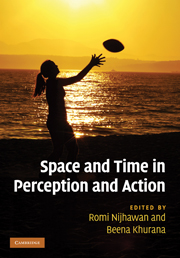Book contents
- Frontmatter
- Contents
- List of contributors
- Acknowledgments
- 1 Space and time: the fabric of thought and reality
- Part I Time–space during action: perisaccadic mislocalization and reaching
- Part II Temporal phenomena: perception
- 10 Saccadic chronostasis and the continuity of subjective temporal experience across eye movements
- 11 Experiencing the future: the influence of self-initiation on temporal perception
- 12 On the perceived interdependence of space and time: evidence for spatial priming in the temporal kappa effect
- Part III Temporal phenomena: binding and asynchrony
- Part IV Spatial phenomena: forward shift effects
- Part V Space–time and awareness
- Index
- References
12 - On the perceived interdependence of space and time: evidence for spatial priming in the temporal kappa effect
from Part II - Temporal phenomena: perception
Published online by Cambridge University Press: 05 October 2010
- Frontmatter
- Contents
- List of contributors
- Acknowledgments
- 1 Space and time: the fabric of thought and reality
- Part I Time–space during action: perisaccadic mislocalization and reaching
- Part II Temporal phenomena: perception
- 10 Saccadic chronostasis and the continuity of subjective temporal experience across eye movements
- 11 Experiencing the future: the influence of self-initiation on temporal perception
- 12 On the perceived interdependence of space and time: evidence for spatial priming in the temporal kappa effect
- Part III Temporal phenomena: binding and asynchrony
- Part IV Spatial phenomena: forward shift effects
- Part V Space–time and awareness
- Index
- References
Summary
Summary
Perceived duration of interstimulus intervals is influenced by the spatial configuration of stimuli. When participants judge the two intervals between a sequence of three stimuli presented with different spatial distances, a greater distance between two stimuli makes the corresponding time interval appear longer (kappa effect, Experiment 1). By employing a choice-reaction time task, we demonstrate that this effect is at least partly due to a facilitating influence of the preceding stimulus on the timing of the subsequent one while the timing of the first stimulus presented is not influenced by the subsequent one. Moreover, reaction times to the subsequent stimulus increased with spatial distance between successive stimuli, and this was valid for a three-stimulus condition (Experiment 2) as well as for a two-stimulus condition (Experiment 3). Thus, our results provide evidence for spatial priming in the temporal kappa effect.
Introduction
Perceiving space and time is often considered to be independent. However, the interdependency of both dimensions has been known for a long time and is most apparent in the perception of moving stimuli. For example, in 1862 Zöllner discovered a subjective spatial contraction of figures when moved behind a vertical slit (anorthoscopic distorted pictures, see also Vierordt 1868; Parks 1965). Through the motion, the slit uncovered only small figure sections at any time, and apparently the perceptual integration of the temporally separated sections contracted the figure spatially. This phenomenon (and related phenomena, e.g., the Ansbacher effect, Ansbacher 1944, or the tandem effect, Müsseler & Neumann 1992) demonstrates that perceived space depends on the temporal characteristics of stimulus presentation, here as a consequence of stimulus motion.
- Type
- Chapter
- Information
- Space and Time in Perception and Action , pp. 181 - 196Publisher: Cambridge University PressPrint publication year: 2010
References
- 1
- Cited by



